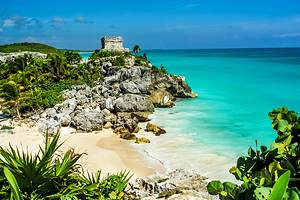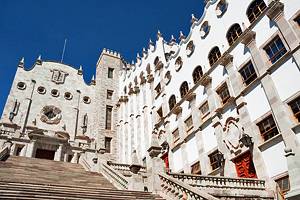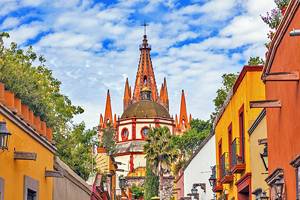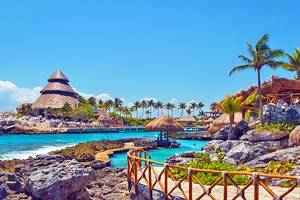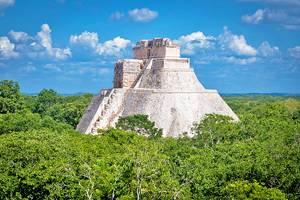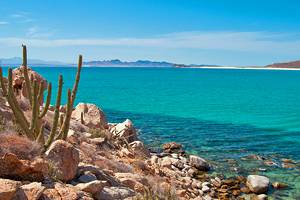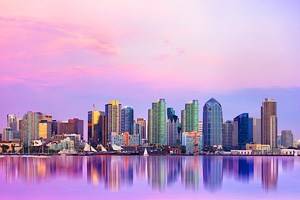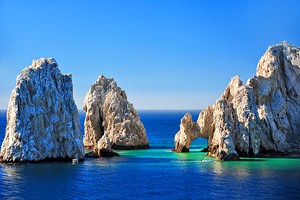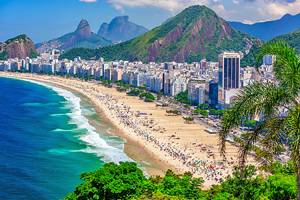Discovering the Cultural & Historic Charms of Aguascalientes, Mexico
The sound of rain tapped softly atop the slick cobblestones along the street in front of the Templo del Senor de Encino. Directly in front of me, I watched beads of water drip from the nose of a bronze statue of a woman in the Jardin de la Paz. The cloudy skies above made the vibrant colors of the colonial-era buildings on either side of me pop in the quiet Encino neighborhood of Aguascalientes. And I breathed deeply the smell of artisanal chocolate that wafted into the streets from the Xocolatl Mexica Encino chocolateria.

It was sensory overload — the sounds, the feel, the smell, the sights. But sensory overload is often how I describe Mexico. This was my first glimpse of Aguascalientes, and so much was said in one quick moment.
To visit Aguascalientes is to discover Mexico on a deeper, more personal level.
While I love the resort towns and beautiful beaches as much as any other Mexico lover, there is so much to be said about its mountainous central regions. Here, towns and cities are often removed from the influence of U.S. and Canadian tourism and provide a more in-depth look at what a day in life in Mexico really looks like. Located in the heart of the country, Aguascalientes is steeped in centuries-old traditions, a history that spans more than five centuries, and personifies so much of what makes Mexico such a magical part of the world.
Located about 300 miles from Mexico City, the state of Aguascalientes is surrounded by stunning sierras. One of the driving forces behind its growth is the auto industry, thanks to the massive Nissan plant in the city. This is the new Aguascalientes. But it's the old Aguascalientes that interests me most.
Here are some of my favorite cultural and historical charms in Aguascalientes.
Jose Guadalupe Posada Museum

This museum- and cathedral-rich city has provided so much influence on Mexican culture over the centuries. The Jose Guadalupe Posada Museum is dedicated to the man whose name it bears. Posada was a lithographer who was born in Aguascalientes in the 19th century. He is best known for his zinc etching of a skull figure, or a calavera, dressed up in traditional European 19th-century garb.
This image, now memorialized in the museum along with hundreds of his other etchings, is known as La Catrina, and is the most important icon for Mexico's Day of the Dead celebrations. You can see where it all began right in the heart of Aguascalientes.
Note that the explanations of the lithographs are in Spanish, so it helps to know a little. But staff at the museum speak enough English to help translate if necessary.
The museum is in the beautiful Encino neighborhood, which is also home to the Templo del Señor del Encino, one of my favorite churches in Aguascalientes for its beautiful stone facade, yellow trip, magnificent wooden doors, and spectacular dome.
Address: Lado norte Jardín del Encino s/n, Dr. Jesús Díaz de León, Barrio Del Encino, Barrio del Encino, 20240 Aguascalientes, Ags., Mexico
Temple of San Antonio

With a striking columned facade and bulbous domes that are almost Kremlin-esque, the Templo de San Antonio defies many architectural norms. Located in the center of Aguascalientes at a busy intersection, this fairytale-style cathedral is unlike any other you'll find in Mexico. The hauntingly beautiful structure is a combination of Neoclassical, Baroque, Gothic, Arabic, and Russian, swirling with colors and stained glass. It was created by Refugio Reyes Rivas, a self-taught architect, and was built at the turn of the 19th century.
Address: Calle Pedro Parga 252, Zona Centro, 20000 Aguascalientes, Ags., Mexico
Parque Tres Centurias

During the 19th century, Aguascalientes was one of the most important hubs in Mexico for rail travel. For many, it was the last stop before crossing the border into the United States. Though the railroad is no longer in operation, its historic rail station depot, historic steam engines, and soaring glass-and-steel railcar workshop have been transformed into the modern-day Parque Tres Centuries.
Within the park are exhibits dedicated to the railroad industry, and many of the historic buildings are now home to classrooms and education spaces for the University of the Arts. Visit the iconic Hidrocalida locomotive, or stop by the largest fountain in Latin America. You can wander through the onsite Museo Espacio. It's a beautiful example of repurposing what was once the defining glory of Aguascalientes into a space for creating new and beautiful expressions of creativity.
If you wander over to the Ferrocarrilero Aguascalientes Museum you'll be able to peek inside the sleeper car of former Mexican presidents.
Plaza tres centurias, Desarrollo Especial Talleres F.F.C.C., 20259 Aguascalientes, Ags., Mexico
Plaza de la Patria

The heart of Aguascalientes Centro Historico is its Plaza de la Patria. One of the oldest parts of the city, this main square is where you'll find the spectacular Cathedral Basilica of Our Lady of the Assumption, the Government Palace, the Municipal Palace, as well as the Legislative Palace, and the iconic Old Imperial Hotel. At the center of the square is the Exedra, a tall column crowned with a sculpture of an eagle devouring a serpent, which is the national symbol of Mexico.
I recommend taking a stroll down Calle Nieto, one of the oldest streets in the city which is still lined with traditional textile shops. It feels like a walk back in time through the days of how things "used to be."
Calvillo

One of the best trips I took in Aguascalientes was to the small town of Calvillo, one of Mexico's iconic "Pueblos Magicos." Pueblos Magicos, or Magical Towns, are towns that are given special government recognition for having elements that highlight Mexico's culture, cuisine, legends, architecture, or history.
Calvillo is a charming town surrounded by mountains, webbed with cobblestone streets and beautiful homes and buildings that creep up the hillside. It's a town known for its guava trees, and guava is an important part of the local economy. You can find it in everything from pastries and sweets to even pizza and mole.
Calvillo is also home to the National Museum of Magical Towns, which has information and artifacts on all 177 Magical Towns across Mexico.
How to Get to Aguascalientes
Aguascalientes has an international airport, but direct flights are limited from the U.S. It has direct flights from Houston, Dallas, Chicago, and Southern California. Visitors can also connect through Mexico City.


